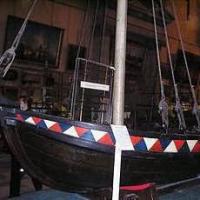Criminal Paris. Tenth District. Strasbourg - Saint Denis. The Gothic style originates here
The French remember glorious victories and their great kings. On the royal road leading from the Church of Saint-Denis to the Louvre, a triumphal arch was erected in 1672. The monument was built to perpetuate the significant victories of the army of Louis XIV, won in the famous battles on the Rhine. Then the royal troops took forty fortresses in two months. The structure was called the “Gate of Saint-Denis” […]
The French remember glorious victories and their great kings. On the royal road leading from Church of Saint Denis before Louvre, a triumphal arch was erected in 1672. The monument was built to perpetuate the army’s victories that were significant for the state. Louis XIV, won in the famous battles on the Rhine. Then the royal troops took forty fortresses in two months.
The building was named "Gate of Saint-Denis" (Porte Saint-Denis), its author is an architect Francois Blondel. Previously there was an entrance gate here. Charles V, built back in the Middle Ages.
Two obelisks are located at the arch supports. They depict royal military trophies in sculptural form. Two figures are installed at the foot of the obelisks - the mythological God of Rivers, holding a cornucopia, with an oar in his hands; a woman sitting on a lying grinning lion. There are seven arrows in the paws of this lion - there were seven regions in the defeated Republic of the United Provinces.
Panel by sculptor Michel Angier crown the arch. Their subjects depict: the capture of Maastricht by Louis and the crossing of the Rhine by the king’s army. "Ludovico magno" - a Latin dedication to the great king is written in bronze letters at the very top of the triumphal gate of Saint-Denis.
The gate of the same name originates from the gate Boulevard Saint-Denis, the ancient one stops him street Saint Denis. Once there, it is worth visiting the old arcade - the Grand Cerf store, which has existed since 1825.
28 Boulevard Saint-Denis 75010 Paris, France
subway.com
How do I save on hotels?
It’s very simple - look not only on booking. I prefer the search engine RoomGuru. He searches for discounts simultaneously on Booking and on 70 other booking sites.
The Abbey of Saint-Denis is most often not included in the standard excursion tourist program. This happens due to the fact that it is located in a very disadvantaged suburb of Paris. But this place is of great historical value and is definitely worth a visit.
The legend of the creation of the abbey
The origin of the name Saint-Denis is associated with the legend of Dionysius, the first bishop of Paris and patron saint of France. As the story goes, he was sent to these parts by the Pantifex to convert the pagan Gauls to the Christian faith. He was executed in Montmartre during the reign of King Valerian: his head was cut off. However, the body of Saint Dionysius approached his head, took it in his hands and walked about another six or seven kilometers to the northeast. After which it fell next to a small settlement, which was later named after him: Saint-Denis. This story happened back in 258 AD. Until now, on the icons of St. Dionysius is depicted holding his head in his hands.
At the burial site of Dionysius of Paris, or rather even above the grave itself, in 475 the church of the Saint-Denis monastery was built with the blessing of Saint Genevieve. At that time there was a Gallo-Roman cemetery here. And in the 7th century, by order of King Dagobert the First, an abbey was erected around it. The ruler himself wished to be buried here. All royals and queens, princesses and princes were buried in the abbey. Information about the number of burials of high-ranking persons differs in different sources, because not all burials have been preserved. Many graves were destroyed.

The Gothic style originates here
The Church of St. Dionysius itself was reconstructed many times: in the seventh century during the creation of the monastery, during the reign of Pepin the Short. In the 12th century, the abbey had already become very influential and powerful in France. Therefore, it was decided to expand it and build new buildings. This large-scale reconstruction began to be carried out by Abbot Suger, an enlightened and outstanding religious figure of his generation, a traveler. He was appreciated and listened to by several French kings (for example, Louis the Fourth and Louis the Seventh).
The idea behind the reconstruction was to reflect the increased weight of France and its culture in Europe and throughout the world. Construction lasted for decades. The abbot wanted to preserve the original appearance. So, as a result of a mixture of architectural traditions and trends, a fusion of Burgundian and Burgundy arose. And the first building erected in Gothic was the Church of the Abbey of Saint-Denis.
Suger the architect was responsible for the creation of high stained glass windows with images of stories from the Bible, a “stained glass rose” above the entrance, which became decorations of the abbey. The Church of Saint-Denis continued to be restored after the death of Abbot Suger. In subsequent centuries, something was constantly changed in it, so the decoration of those centuries has only partially survived to this day.

Tomb of the French Kings
In the 13th century, Louis IX ordered the burials of all the royals who ruled before him to be moved to the territory of the Abbey. The church also began to serve as the tomb of the kings of France.
From the tombstones of different times, one can trace how funerary art changed and developed in different centuries. Some of the slabs and monuments are decorated with statues of sleeping monarchs (this is typical for the twelfth century); during the Renaissance, tombstones were decorated with compositions with the hope of resurrection.

Abbey of Saint-Denis during the revolution in France
The Hundred Years' War and the Huguenot Wars caused significant damage to the abbey's architecture, but the tombs were mostly damaged during the French Revolution. The ashes of the Autocrats were dumped in a ditch and buried, a large number of works of art stored on the territory were taken out or lost.
They say that the revolutionaries put the body of King Louis the Fourth on public display. For a while, anyone could come up and look at the remains. Some bodies were torn to pieces, carried home by necrophiliacs, and even sold.
The history of the Abbey of Saint-Denis almost ended with this black page. The cathedral was supposed to be demolished by decree of the National Assembly, but at the last moment it was canceled.

In 1814, the relics of the kings were dug up and collected in the crypt into an assuary. And in 1869, the basilica of the Abbey of Saint-Denis itself was restored by the remarkable French architect Violet-le-Duc, who restored more than one great monument. He worked, for example, on the Cathedral of Notre Dame, Mont Saint-Michel and others. Back in the 17th century, Saint-Denis again began to function as a tomb for the crown.
King's burial ceremony
In the 17th century, according to the theory of French jurists, the king should be immortal. This was emphasized in every possible way with the help of a large number of burial rituals. The autocrat had a dual essence: man and For example, the funeral of King Henry the Fourth lasted forty days. The monarch's entrails were removed after death and buried separately and without ceremony in the Abbey of Saint-Denis. The heart was cleaned, infused with alcohol, and rubbed with herbs, it was placed in a cloth bag, then in a lead box, which was then placed in a silver box. The hearts of monarchs were kept in different places. They were given special importance, since it was with their hearts that they rooted for France. The body was embalmed and buried separately. An effigy of the king was also made from straw, although none of them survived after the French Revolution. The effigy of Henry the Fourth imitated the life of a living king for 10 days using special rituals.

In Saint-Denis, all the royal regalia accompanied the embalmed body until the very last moment: the utterance of the iconic phrase of the transfer of the throne to new hands.
The king is dead... Long live the king!
After this phrase, the king’s regalia followed as quickly as possible to Reims for the coronation.
Meaning of Saint Denis
Starting from the 11th-12th centuries, the abbey had great weight in France: not only monarchs were buried here, but also their heirs were trained, and queens were crowned here. The monastery of Saint-Denis carried out educational activities in the Middle Ages, the monks were engaged in charity: there was a hospital, a nursing home and an orphanage.

The abbey basilica also has architectural significance: it is the source of the development of the Gothic style, and stained glass art was born here.
The necropolis of Saint-Denis reflects the development of funeral ceremonies in France and is a unique monument, with 51 tombstones.
In 2004, the heart of Marie Antoinette's son was buried here, who, although he did not rule, was recognized as king by many European countries and in the United States.
How to get to the abbey
The thirteenth line will take you to the basilica. The stop is called Basilique St Denis in the direction of the outskirts station.
You can also use the high-speed train (in Paris it is abbreviated RER), line D, the station is called Saint Denis.
Basilica opening hours
You can get into the altar part of the church completely free of charge. From here you can look at the burials through the bars. The basilica is open to the public almost every day, except when funerals or weddings take place there. Entrance to the necropolis is paid, it is located on the right side of the Saint-Denis Cathedral. Photos inside are prohibited.

No events in the history of France could completely destroy this burial place of great monarchs, a monument of French culture, witness to the change of times and cultures. The visitor will undoubtedly be strongly impressed by the Gothic vaults of the cathedral, virtuoso stained glass windows and gravestones that vary widely in style: from gloomy medieval ones to Renaissance monuments that inspire hope for resurrection and eternal life.
The French town of Saint-Denis is located ten kilometers from the main part of Paris, which can be reached by RER train (St-Denis-Basilique station).
Throughout the 20th century, Saint-Denis was considered the most industrially developed city in its region, and it is not surprising that it was here that the main bastion of the French Communist Party was formed.
For the capital's bourgeoisie, the emerging political threat of the “red suburbs” (Banneux-Rouge) gradually developed into the social instability of the “hot suburbs” (Banneux-Chaud).
However, numerous tourists are not at all averse to visiting this relatively poor, but at the same time quite cheerful suburb of Paris, the prestige of which is supported by two of the most significant attractions: the ancient Basilica of Saint Denis and the ultra-modern sports complex Stade de France, where the final match of the FIFA World Cup was held in 1998.
The central part of Saint-Denis still retains the characteristics of a small provincial town, but the area adjacent to the basilica has changed quite a lot since past times.
Now there are unusual, fortress-like multi-storey buildings, young people riding skateboards and mopeds, women buying goods in African grocery stores, and men who have just arrived from conflict zones begging, and these are not all the everyday examples present in this city.
At the local market, open three times a week (Tuesday, Friday and Sunday morning), located on the main square of Jean-Jaurès, all goods - vegetables, as well as cheap trinkets, fabrics and clothing - are several times cheaper than in the markets of the French capital .
Next to the market there are spontaneous retail outlets belonging to various ethnic groups, where meat waste - ears, legs, tails and bladders - is laid out on the counters, the quality of which speaks volumes about the fact that very poor people live here.
About a five-minute walk from the basilica is the Museum of Art and History of the French town of Saint-Denis (opening hours Monday, Wednesday, Friday from 10.00 to 17.30, Thursday 10.00-20.00, Saturday and Sunday 14.00-18.30). All the premises of this museum are located in the former Carmelite monastery on rue Gabriel Peri.
The shortest route to the museum is along rue Legion-d'Honneur, third lane on the right. The exhibits on display in the museum may not be the most impressive, but the entire exhibition is beautifully organized. The museum's collections contain quite interesting archaeological finds, and industrial landscapes of the 19th-20th centuries, including the Saint-Denis Canal, also deserve special attention.
The museum has a unique historical exhibition, which is entirely dedicated to Paris Commune: posters, cartoons, paintings, slogans - all this is accompanied by audiovisual means. There is also a collection of manuscripts and rare editions of the communist poet Paul Eluard, a worthy son of his native suburb of Saint-Denis.

Sports complex Stade de France
Continuing along rue Gabriel-Péry, in about ten minutes you will arrive at the Porte-de-Paris metro station. Nearby you will see a wide pedestrian bridge crossing the motorway and the Saint-Denis Canal, along which you can then go to the sports complex Stade de France, which witnessed the victory of the French team at the World Cup in 1998.
This stadium of a non-standard elliptical shape, the construction of which cost more than 430 million euros, looks especially good in the evening with beautiful lighting.
When the stadium does not host sporting competitions or mass cultural rock events, tourists have a real opportunity to explore its sports grounds and a small museum telling about the short but very eventful history of the stadium (visiting hours daily from 10.00 to 17.00, cost 10 euros).
To return from the French town of Saint-Denis back to Paris, you should cross the canal using the pedestrian bridge located on the north side of the stadium. Further to the capital you can walk, using the pedestrian path along the canal.
Some of the neighborhoods located here are currently being rebuilt and will need to be bypassed, while others are very dilapidated or completely abandoned by residents, so you may feel uncomfortable here, but continue your way anyway, and in the end, no more than through 2 hours, you will find yourself at the Porte de la Villette metro station.
Despite the fact that this road is only picturesque in places, you will still have an excellent opportunity to get acquainted with the forgotten life of the Parisian lower classes, covered with the dust of centuries.



Still, it’s good to be a tourist and not know what streets you’re walking down in Paris, you don’t realize that you’ve moved from Little Turkey to Little Africa or found yourself at the mercy of local Chinese or Indians who control all the shops and restaurants around. An invisible hand has divided the Parisian neighborhoods in the 10th, 9th and other arrondissements, located between the Grands Boulevards, and the mafia, ethnic and territorial, that rules here, actually takes money from you for every purchase, every glass of wine or cup of coffee you drink, an eaten croissant or cake in your pocket. Let's continue walking along the dark Parisian alleys and gateways. 
All the evil concentrated here can be safely ignored, but it will remind you with every step, when in the alleys between the Boulevard Magenta, the Boulevards Bonne-Nouvelle and the Rue Saint-Denis, or the Boulevards Sevastopol and Saint-Martin, finally, on the outskirts of the Gare du Station Nord (i.e. Northern) or Gar D "Est (East), which ends with the most criminal of all Strasbourg Boulevard, or on the Faubourg-Saint-Denis street, full of pimps and prostitutes, between the cramped and long streets of Enghien, Petit-Hercury or Chateau-Deau, you will meet crowds of blacks, and when you cross to the other side - Turks, Turkish women, Turkish children who don’t speak a word of French. 
It just seems that the lights are peaceful, these loafers hanging out in the gateways of Saint-Denis. Grange says about them: “Cameroonians are the kings of forgery - they forge coupons, tickets, blue cards. Congolese “work” in the field of, so to speak, ready-made clothes: stolen clothes, counterfeit products. People from Ivory Coast have a nickname - “ 36 15". They specialize in fake charities - they will always find a way to get money out of you for the starving Ethiopians or Angolan orphans. A wonderful example of solidarity. But the most dangerous are the Zairians. Their domain is drugs. They run the whole block." 
On Starsburg Boulevard, a hub of immigrants, hairdressers - Antillean and African - compete for space on the sidewalk with vendors selling cosmetics and cheap jewelry. The restaurants are run by the Chinese - although you won’t see them while eating purely French cuisine in these cozy establishments. 
We move further, from the Gare du Nord or along the Grands Boulevards - and soon we find ourselves in directly Turkish territory, bounded on the south by Bon Nouvel and Saint-Denis boulevards, on the east by Faubourg-Poissonnière Street and on the west by Faubourg-Saint-St. Martin. To the north, the border was closed by the intersection between Lafayette Street and Magenta Boulevard. The backbone was the Strasbourg Boulevard, rising to the Gare de l'Est, with uneven branches of the streets Petit-Ecurie and Chateau d'O... The heart of the zone, which supplied blood to this fragment of the East, beats in the depths of the Strasbourg-Saint-Denis metro station. 
Real Parisians try to avoid this area, and no wonder - crime, theft, and fraud are rampant here. Although external prosperity deceives crowds of tourists scurrying around as if nothing had happened in places where ordinary people are afraid to enter. 
However, outwardly everything is decent and tourists are not bothered. All the active life of the quarter is concentrated inside. The houses are typical for Paris, you won’t guess anything either. They all have the same topography: in the basement and on the first floor there are shops, on the second and third there are workshops; on the upper floors and in the attic there are living quarters, overcrowded, partitioned and fenced off apartments, similar to a Chinese puzzle. 
Arc de Triomphe of Saint Denis. Remember this place - this is the gateway to the Turkish quarter. 
Here they sew clothes, the same contraband, which you will then buy in Parisian private stores at sales and carry in trunks to Russia on your hump. The Turks do not control this craft - the main ones here are Jews, but since the 50s, Turkish immigrants have managed to become an important link in the chain. They were suppliers to wholesalers, because they employed hundreds of workshops and homeworkers; thousands of hands worked thousands of hours and were able - almost - to compete with the Chinese. 
Just a few hectares, between the Rue Petite-Ecurie, the courtyard and the passage of the same name, the Rues D'Enchen, De Lechiquier and Faubourg Saint-Denis, where most of the houses, attics and basements are inhabited exclusively by Turks. Over there in the back yard facing to the warehouse, in fact there is a mosque; and in that seemingly empty house in the back of the courtyard, the headquarters of the extreme left, the Turkish communists, is located ... 
The Kurdish General Staff will suddenly meet in one house. In another, huge, like an anthill. The Laz live, natives of the Black Sea coast in northwestern Turkey, professional warriors. Mustafa Kemal Atatürk personally selected his guards from among these people. And if you believe the Greek myths, the Laz guarded the Golden Fleece in Colchis. 
Everywhere there is an atmosphere of moving, everyone is moving somewhere, throwing something away, taking things out. Even the sellers of numerous shops are ready to break anchor at any moment. There are trolleys with sandwiches at the edge of the sidewalks - so you can have a snack on the run; and delicious, I give you my head to be cut off! - travel agencies work right there - people come and go all the time; There are photocopiers everywhere - local residents make copies of documents. The windows of real estate agencies are full of advertisements that are incomprehensible to tourists: “FOR RENT”, “FOR SALE”. 
Cinema "Rex", a cult place, once a meeting point for the bohemian public, and now just a cinema museum. 
Here in the alleys you can come across Turkish baths, indistinguishable from real ones, sewing workshops filled with workers from Gaziantep, from the villages of Anatolia, who do not understand a word of French and most likely arrived here illegally, in the hold of a ship. 
Nice place, Boulevard Bonne Nouvelle, best viewed from the car window. 
They look at you sideways, as if you were an uninvited stranger. It only seems to you that you have blended in with the crowd, but in fact, you have long been noticed and are being hooked. 
Here Bonne Nouvelle meets Rue Saint-Denis and Little Turkey ends, ceding invisible control to Little Africa. 
Behind the gates of Saint-Denis are well-groomed, clean quarters, in the depths of which the Turkish “Red Heads”, the most brutal Shiite Muslims, gather. They live in a closed community, or rather a community. Everyone chooses a “sworn brother”, a “dedicated comrade-in-arms”, and so “as a couple” they go to meet Allah, killing in His name. 
Here's what it all looks like. No horror, no pools of blood. Only the smells of coffee and tobacco. And behind the walls are endless women's dormitories for Turkish workers. 
We enter the Third Arrondissement via the Boulevard Saint-Martin and the scenery changes. There are no Turks here anymore, Muslims don’t appear here. There are prostitutes and pimps here. They are controlled by the French mafia. 
And clochards. 
Boulevard Sevastopol. 
The cesspool ends here. Real Parisians appear, French to the core. Let's look at them. 






Getting closer to the center. Everything is cleaner and more prosperous. Goodbye Little Türkiye.
 All types of RNA. Structure and functions of RNA. Types and types of RNA cells
All types of RNA. Structure and functions of RNA. Types and types of RNA cells In which word is the letter denoting the stressed vowel sound correctly highlighted?
In which word is the letter denoting the stressed vowel sound correctly highlighted? Military Medical Academy named after
Military Medical Academy named after Presentation on the topic "appeal" Punctuation - spelling warm-up
Presentation on the topic "appeal" Punctuation - spelling warm-up “Indecent peace”: how the Treaty of Brest-Litovsk influenced the course of Russian history
“Indecent peace”: how the Treaty of Brest-Litovsk influenced the course of Russian history Political reforms of Peter I
Political reforms of Peter I Astakhov Pavel Alekseevich, lawyer: biography, personal life, career
Astakhov Pavel Alekseevich, lawyer: biography, personal life, career